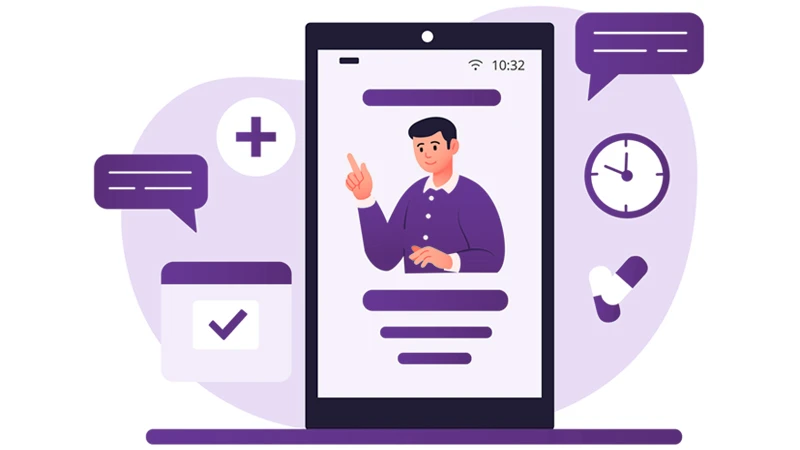- Insights
- Digital Experience
- Article
The omnichannel advantage: A path to healthier patient experiences

Patient well-being has always been the primary focus of the healthcare industry.
However, a number of challenges have prevented the optimization of the overall patient experience. Fragmented engagement across touchpoints has created information gaps; inefficient communication between various stakeholders leads to delays in care and miscommunication; data silos stand in the way of delivering highly personalized support; and the slow transition to providing patients with self-service options has put extra pressure on healthcare staff that are grappling with an ever-increasing workload. In fact, 62% of nearly 2,000 customers surveyed in the U.S. by The Harris Poll reported that the healthcare system feels like it's designed to be confusing.
Health leaders are recognizing that the existing model of care is unsustainable and in need of a transformation. A recent survey conducted by Harvard Business Review Analytic Services revealed that 57% of 115 healthcare industry executives consider improving customer experience (CX) their top business priority for the year ahead — surpassing all other priorities, including increased efficiency and higher revenues.
The COVID-19 pandemic catalized a wave of innovation within the healthcare sector, compelling organizations to break free from traditional constraints and embrace virtual care, e-triage and telemedicine. As consumers become more accustomed to interacting with brands in the digital realm, the healthcare industry finds itself at a pivotal crossroads.
Leaders have the opportunity to further enhance patient engagement and improve overall healthcare experiences with omnichannel CX — the use of connected channels to communicate with patients and provide them with coordinated, seamless care services. Not only does this directly address the aforementioned challenges, it also unlocks an array of possibilities for those willing to adapt to the changing healthcare landscape.
The benefits of moving to omnichannel CX
In the world of healthcare, communication is paramount, and the method by which it occurs can greatly impact patient experiences. To understand the true value of transitioning to omnichannel CX, it's essential to differentiate it from the more traditional multichannel approach.
Multichannel vs. omnichannel: What sets them apart?
Multichannel communication, as its name implies, uses multiple communication channels — such as phone, email, chat and social media — to engage with users throughout their customer journey. Each channel operates independently, offering its own distinct advantages. However, the drawback of multichannel interactions is their lack of interconnectedness. Patients using multiple channels often find themselves restarting their journey at each new touchpoint, which can lead to frustration and hinder satisfaction.
On the other hand, omnichannel interaction is a more sophisticated and patient-centric approach. It also leverages multiple communication channels, but the key distinction is that all of these channels work in harmony. They seamlessly exchange information about the patient, allowing for a truly cohesive experience. With omnichannel CX, a patient can initiate an interaction via email and effortlessly switch to online chat with a healthcare representative, with no loss of context. All information from each interaction is stored and shared across the various platforms, ensuring a holistic understanding of the patient's needs and history.
The transformative benefits of omnichannel CX
With the adoption of an omnichannel patient experience comes a number of key benefits for healthcare brands, such as:
- Enhanced patient engagement: Omnichannel CX enables healthcare brands to create a unified, consistent and highly personalized patient experience across all interactions. This approach leads to improved patient engagement, as patients can interact with their healthcare provider through the channels they prefer with minimal effort.
- Efficient communication: Omnichannel strategies streamline communication among healthcare providers, patients and other stakeholders, reducing miscommunications and enhancing the overall coordination of care.
- Improved data management: The integration of data from various sources and systems is a powerful aspect of omnichannel CX. Comprehensive patient information allows healthcare brands to gain a complete view of patient data, enabling more informed decision-making, enhanced treatment plans and a higher level of personalized care.
- Empowered patients: Granting patients easy access to their health records, test results, appointment scheduling and educational resources through the channels of their choice fosters better patient-provider relationships and promotes proactive health management.
- Increased operational efficiency: Omnichannel solutions can streamline administrative processes, such as appointment scheduling and billing. Moreover, improved communication can help decrease patient no-show rates.
- Gain a competitive advantage: By differentiating themselves from traditional providers and meeting the evolving expectations of patients, healthcare providers with an omnichannel strategy position themselves as leaders in delivering patient-centric care.
How to prepare for an omnichannel transition
Transitioning from multichannel to omnichannel CX is a multifaceted journey that demands planning, technological considerations, cultural adaptation and cross-organizational collaboration. Consider the following key steps as part of the initial planning process:
Step 1: Consider partnering with an experienced omnichannel provider
The process of getting started with an omnichannel transition can feel daunting. Collaborating with a digital customer experience partner that has a proven track record in implementing omnichannel solutions can be invaluable. Such partners possess deep insights into best practices, industry trends and emerging technologies relevant to omnichannel engagement. Leveraging their expertise and specialized knowledge ensures that your omnichannel transition starts off on the right foot and is well-informed and optimized.
Step 2: Complete an assessment
Conduct a thorough assessment of your existing patient engagement processes, technology infrastructure and data management systems. This is the stage where you should clearly define your objectives for the transition, such as enhancing patient engagement, improving communication and increasing operational efficiency. These objectives will serve as your guiding principles throughout the process.
Step 3: Get executive buy-in
As with any notable change in an organization, obtaining buy-in from executive leadership is paramount. Top-down support is critical for securing the necessary resources, aligning the transition with organizational strategy, promoting collaboration, overcoming resistance and managing risks. It also signifies the long-term commitment required for the initiative. Ultimately, gaining executive support sets the tone for the entire organization and increases the likelihood of achieving desired outcomes.
Step 4: Create cross-functional teams
It's not just executive leadership that you need to engage. Building an exceptional omnichannel experience cannot occur in a silo, it necessitates the expertise and insights of various business units within an organization. Form a cross-functional team of representatives from IT, marketing, operations, compliance and customer service to ensure that team members are well-versed in the organization's objectives and aligned with the vision of your omnichannel transformation.
Step 5: Technology selection and integration
Identify and implement the appropriate technology stack to support omnichannel interactions. This may encompass patient portals, mobile apps, CRM systems, a cloud contact center, chatbots, telemedicine platforms and data analytics tools (more information on effective tools and technologies for a seamless omnichannel experience can be found later in this article). It is pertinent to ensure a smooth integration of these technologies to facilitate data sharing and provide a unified view of patient information.
Step 6: Training
The next focus should be on training your employees and completing thorough testing of your omnichannel system. When training your employees, an emphasis should be placed on empowering them to proficiently use new technology while cultivating an understanding of the omnichannel strategy.
Step 7: Test
Don't underestimate the importance of testing. Rigorous testing of your omnichannel ecosystem will help identify and rectify any technical glitches or user experience issues.
Step 8: Monitor and measure
Continuously gather feedback from patients and staff, using it to drive iterative improvements. Patient satisfaction surveys, engagement metrics and an analysis of complaints and issue resolution can give you insight into how successful your strategy is from a patient perspective. Feedback from employees on workflow efficiency, additional training and support needs, data accuracy and accessibility can also be beneficial.
Overcoming omnichannel transition challenges
By proactively addressing common hurdles with thoughtful strategies and solutions, healthcare brands can enhance their chances of successfully executing an omnichannel approach and reaping the associated benefits.
Some of the common challenges to be mindful of include:
- Data integration: Healthcare organizations often contend with data stored across disparate systems, making the creation of a unified patient view a daunting task. To overcome this challenge, invest in robust data integration solutions that can aggregate data from various sources into a centralized database. Implement master data management practices to ensure data accuracy and consistency throughout the organization.
- Regulations and compliance: The heavily regulated nature of healthcare adds complexity to omnichannel efforts. Ensure strict adherence to regulations by implementing robust security measures, data encryption and access controls to safeguard patient information. Conduct regular compliance audits and provide training to staff on data security and privacy best practices.
- Resistance to change: Overcome this challenge by developing a comprehensive change management plan that includes staff training, transparent communication about the transition and active involvement of employees in the process. Highlight the benefits of the omnichannel approach to motivate buy-in from the entire organization.
- Technology gaps: Many healthcare organizations rely on legacy systems that may not readily support modern omnichannel technology solutions. To bridge these technology gaps, evaluate the need for system upgrades or replacements. Consider leveraging middleware or API integration to make legacy systems compatible with omnichannel initiatives.
- Lack of employee experience: Some employees may lack the necessary skills and knowledge for supporting omnichannel systems and data analytics. Provide training and upskilling opportunities to your staff.
- Data security threats: The increased digital interaction associated with omnichannel solutions heightens the susceptibility of healthcare organizations to data breaches and cyberattacks. To mitigate this risk, invest in robust cybersecurity measures, including encryption, intrusion detection systems and employee cybersecurity training. Stay up-to-date with the latest security threats and best practices to ensure data security and patient privacy.
- Measuring return on investment (ROI): Define key performance indicators (KPIs) that align with your organization's objectives. These KPIs may include Missing resource for 50r1ehn1sTn5H9cjodfENw related to patient satisfaction, reduced no-show rates, increased appointment bookings or other patient-centric goals. Regularly analyze data to measure the impact of the omnichannel strategy against these predefined metrics to gauge the effectiveness of your omnichannel CX approach.
Effective tools and technologies to create a seamless omnichannel experience
Achieving an omnichannel experience that improves patient outcomes demands a well-orchestrated blend of tools and technologies.
Back-end technology
At the heart of managing patient interactions across channels is a robust customer relationship management (CRM) system. This technology centralizes patient data, appointment scheduling and communication history, offering a 360-degree view of the patient. A CRM empowers healthcare providers to personalize their patient interactions and provide a consistent experience across various channels via access to pertinent data.
Moreover, when it comes to optimizing your strategy, the implementation of tools for real-time performance monitoring and analytics is critical. These technologies help identify issues, optimize processes and track KPIs. By gathering and analyzing data, healthcare organizations can continually refine their approach, ensuring that patient engagement remains at the forefront of their efforts.
The cloud plays a vital role in enabling omnichannel CX by providing a scalable and agile infrastructure for data sharing and accessibility across multiple channels. Cloud-based contact center solutions help to centralize patient data and ensure real-time synchronization. They are also often cost effective, flexible, and scalable, serving to enhance the availability of information for both patients and healthcare providers.
Patient-facing applications
Behind the scenes, the cloud, CRMs and performance monitoring tools play a crucial role in enabling omnichannel CX. However, it's the various consumer facing channels that patients will directly engage with that will have the biggest impact on their satisfaction. For example, patient portals serve as digital gateways, empowering users to access health information, schedule appointments and engage with healthcare providers. Telehealth platforms offer convenience through virtual consultations and remote monitoring, while AI-powered chatbots can provide immediate support around the clock.
These channels are important for customer care delivery, but they do not constitute an omnichannel experience. The true magic unfolds when technologies like mobile apps, telehealth platforms and chatbots are interconnected and collaborate with back-end systems to, for example, make it easy for a patient to effortlessly transition from a telehealth consultation to an in-person visit the following week, and then settle their account using a chatbot. Creating an effortless experience for patients across all channels is where the full benefits of omnichannel are realized.
Get started on your journey to omnichannel CX
Transitioning to omnichannel CX can help healthcare providers improve their patient experience by leaps and bounds. But the transition is not just a final destination, it's a dynamic journey that requires careful preparation, collaboration, technology adoption, training and continuous refinement to better meet the ever-evolving needs of patients in today's healthcare landscape.
Reach out to one of our digital CX specialists today to see how our expertise, cutting-edge technology and engaged team members can help your brand deliver intelligent and effective experiences that improve health outcomes.



